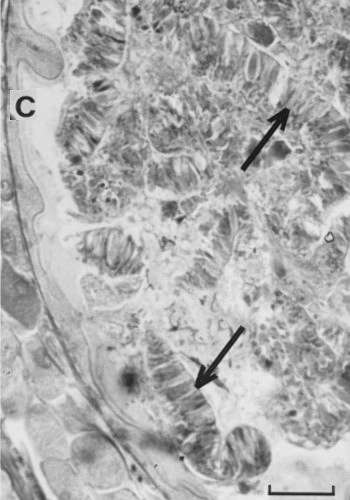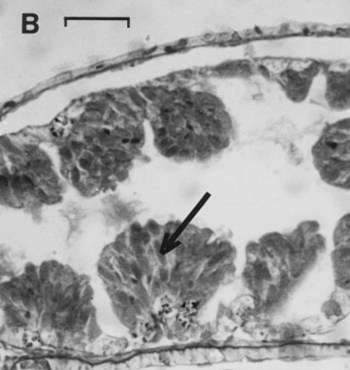

Coral feeding - utilising different parts of the coral tissue
PHOTO
C, Section through the stomach of a recently feeding Phestilla minor showing strips of still intact coral tissue scraped from the coral skeleton.
B, section through a ceras of Phestilla minor, showing cells of digestive gland packed full of spirocysts from its coral prey. Scale bar = 40 microns. PHOTOS: Bill Rudman.
RELATED TOPIC
The aeolid nudibranchs Phestilla lugubris, Phestilla minor, and Cuthona poritophages, and the arminoidean Pinufius rebus, whiich all feed on the coral Porites, appear to utilise different parts of the coral tissue. In the photos to the right we can see that Phestilla minor, strips large layers of the coral tissue off the coral skeleton and in the digestive process appears to absorb one class of nematocyst, the spirocyst, which can be found packed into the digestive gland cells. In contrast, Phestilla lugubris separates out the spirocysts on its stomach and there is no sign of them in the ducts or the cells of the digestive gland. From histological studies, it can be said that Cuthona poritophages absorbs and breaks down the zooxanthellae, but other parts of the coral tissue are porbably utilised as well. Pinufius rebus is the only one of the four for which there is good evidence to show that it is able to retain symbiotic zooxanthellae from the Porites colony it feeds on, keeping them alive for its own nutrition.
While these four animals, at first sight, seem to be an ecologist's dream example of resource partitioning they are clearly not. All four animals eat all the coral tissue, they just utilise their food in different ways. If this was a true case of resource partitioning, each species would only eat a particular part of the colony, one the mucous secretions, one perhaps the polyp tentacles, etc, etc.
References:
•Rudman, W.B. (1979) The ecology and anatomy of a new species of aeolid opisthobranch mollusc: a predator of the reef-forming coral Porites. Zoological Journal of the Linnean Society 65: 339-359.
•Rudman, W.B. (1981) Further studies on the anatomy and ecology of opisthobranch molluscs feeding on the scleractinian coral Porites. Zoological Journal of the Linnean Society 71: 373-412.
•Rudman, W.B. (1982) The taxonomy and biology of further aeolidacean and arminacean nudibranch molluscs with symbiotic zooxanthellae. Zoological Journal of the Linnean Society 74: 147-196.
Rudman, W.B., 1999 (October 4) Coral feeding - utilising different parts of the coral tissue. [In] Sea Slug Forum. Australian Museum, Sydney. Available from http://www.seaslugforum.net/factsheet/corafeed2
